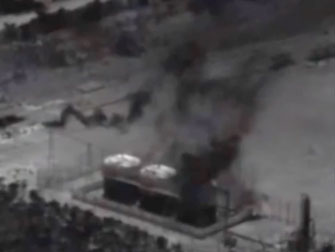Air
Air pollution from hydrofracking come in many varieties. There is dust from truck traffic, dust from construction, and diesel fumes which are easily appreciated by our eyes and our noses. But one of the most toxic types of air pollution is insidiously invisible to our eyes. Volatile organic compounds, or VOCs, such as benzene and formaldehyde (yes, the same stinky stuff that that frog in biology class was preserved in), are released both intentionally and unintentionally from gas collection and treatment equipment. These chemicals contribute to asthma- inducing smog, are toxic to our organs and significantly raise the risk of cancer to those who inhale them. While our eyes cannot detect these emissions, infrared photography has recorded dramatic clouds of black VOCs issuing from gas facilities, as captured on this video released by the Texas Commission on Environmental Quality. Infrared video camera captures VOCs at Texas gas facilities
In the west where hydrofracking has been used to extract gas from the Barnett and Haynesville shale formations, elevated levels of benzene were documented by the Texas Commission on Environmental Quality in Dish, Texas due to leaky compressor stations. A Health Impact Study conducted by the Public Health Department in Garfield County, Colorado also documented unhealthy spikes of VOCs.
An air quality permit issued by the WV Air Quality Board that allows Chesapeake Energy to operate 18 compressors within a 3-mile area is being challenged by a group of Wetzel County landowners. These concerned citizens have organized as the Wetzel County Action Group. The issue is that currently each compressor station is evaluated individually rather than collectively. The argument of the Wetzel group is that collectively, the emissions exceed air quality standards of safety. This generates an immediate problem for residents who live locally as well as contributing to smog in more distant places downwind.
REFERENCES:
Texas Commission on Environmental Quality Interoffice memo, 10-27-09
Garfield County Health Impact Assessment Draft report, September, 2010


{ 1 comment… read it below or add one }
First of all I would like to say thank you! I had a quick question in which I’d like to ask if you don’t mind. I was curious how you decide what to post, given the wide and extensive array of fracking disturbance.
Seems to me there are local land disturbances, regional water and air pollution, plus global climate impacts. How can all this be ignored by DEP, DEC, EPA and the UN?